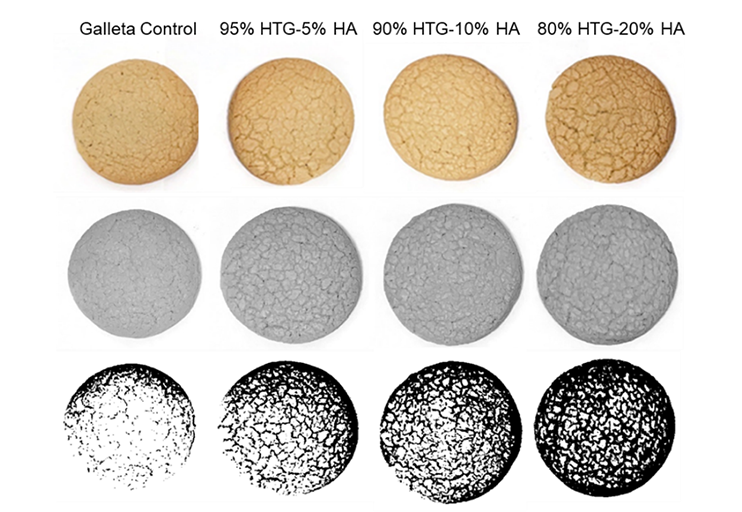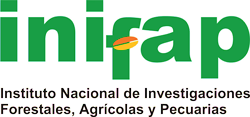Image analysis applied to morphological properties in wheat and oat cookies
DOI:
https://doi.org/10.29312/remexca.v16i5.3784Keywords:
cookie firmness, image segmentation, surface cracksAbstract
The present study was conducted at the Center for Research in Food and Development in 2024. Image analysis is an essential tool that can be used in food process control. This study aimed to analyze, using imaging techniques, the morphological properties of cookies made with wheat and oats in different percentages and their relationship with cookie firmness. The texture profile of the dough obtained from the different formulations, and the weight, diameter, height, and firmness of the cookies were determined. A morphological characterization of the cookies was carried out by means of image analysis. These measurements focused on the overall color of the surface, as well as the characteristics of the surface and internal texture of the cookies through the analysis of the crumb. The results showed decreased firmness (151.96 N to 103.17 N) as the percentage of substitution increased, a similar behavior was observed in the weight and height of the cookie, whereas the diameter was not affected. Regarding the image analysis, greater cracking of the cookie surface was observed as the percentage of substitution increased. Color changes were observed in the crumb towards lighter areas, indicating a decrease in bubbles in the cookie crumb. Image analysis can be an important alternative to determine the quality of a finished product, in this case, a cookie.
Downloads
References
AACC, 2000. Approved Methods of American Association of Cereal Chemists. 10th Ed. The Association, St. Paul, MN, USA. Methods 44-15, 46-13, 30-25, 08-01. Baking Quality of Cookie Flour Method 10-50D.
Abdollahi-Moghaddam, M. R.; Rafe, A. and Taghizadeh, M. 2015. Kinetics of color and physical attributes of cookies during Deep fat frying by image processing techniques. Journal of Food Processing and Preservation. 39(1):91-99. https://doi:10.1111/jfpp.12268.
Abdullah, M. Z.; Guan, L. C.; Lim, K. C. and Karim, A. A. 2004. The applications of computer vision system and tomographic radar imaging for assessing physical properties of food. Journal of Food Eng. 61(1):125-135. https://doi.org/10.1016/S0260-8774(03)00194-8.
Ahmed, J. and Basu, S. 2022. Advances in food rheology and its applications. development in food rheology. Woodhead Publishing, Second Edition. 1-4 pp.
Ataş, M.; Yardimci, Y. and Temizel, A. 2012. A new approach to aflatoxin detection in chili pepper by machine vision. Computers and Electronics in Agriculture. 87(8):129-141. https://doi.org/10.1016/j.compag.2012.06.001.
Bennedsen, B. S.; Peterson, D. L. and Tabb, A. 2005. Identifying defects in images of rotating apples. Comput. Electron. Agric. 48(2):92-102. https://doi:10.1016/j.compag.2005.01.003.
Blanco, M. S.; León, A. E. and Ribottaa, P. D. 2019. Incorporation of dietary fiber on the cookie dough. Effects on thermal properties and water availability. Food Chemistry. 271(2):309-317. https://doi.org/10.1016/j.foodchem.2018.07.146.
Blasco, J.; Aleixos, N.; Cubero, S.; Gomez-Sanchis, J. and Molto, E. 2009. Automatic sorting of satsuma (Citrus unshiu) segments using computer vision and morphological features. Comput. Electron. Agric. 66(1):1-8. https://doi.org/10.1016/j.compag.2008.11.006.
Brosnan, T. and Sun, D. W. 2004. Improving quality inspection of food products by computer vision: a review. Journal of Food Eng. 61(1):3-16. https://doi.org/10.1016/S0260-8774(03)00183-3.
Dammer, K. H.; Möller, B.; Rodemann, B. and Heppner, D. 2011. Detection of head blight (Fusarium ssp.) in winter wheat by colour and multispectral image analyses. Crop Protection. 30(4):420-428. https://doi:10.1016/j.cropro.2010.12.015.
Du, C. J. and Sun, D. W. 2004. Recent developments in the applications of image processing techniques for food quality evaluation. Trends in Food Science and Technology. 15(5):230-249. https://doi.org/10.1016/j.tifs.2003.10.00.
Du, C. J. and Sun, D. W. 2006. Learning techniques used in computer vision for food quality evaluation: a review. Journal of Food Eng. 72(1):39-55. https://doi.org/10.1016/j.jfoodeng.2004.11.017.
Fustier, P.; Castaigne, F.; Turgeon, S. L. and Billaderis, C. G. 2009. Impact of commercial soft wheat flour streams on dough rheology and quality attributes of cookies. Journal of Food Engineering. 90(2):228-237. https://doi.org/10.1016/j.jfoodeng.2008.06.026.
Gerrard, D. E.; Gao, X. and Tan, J. 1996. Beef marbling and colour score determination by image processing. Journal of Food Science. 61(1):145-148. https://doi.org/10.1111/j.1365-2621.1996.tb14745.x.
Hoseney, R. C. and Rogers, D. E. 1994. Mechanism of sugar functionality in cookies: the science of cookie and cracker production. In: Faridi, H. Ed. 1st. St. Paul, MN. American Association of Cereal Chemists. 203-225 pp.
Inglett, G. E.; Chen, D. and Liu, S. 2015. Physical properties of gluten-free sugar cookies made from amaranth-oat composites. LWT-Food Science and Technology. 63(1):214-220. http://dx.doi.org/10.1016/j.lwt.2015.03.056.
Islas, A. R.; Preciado, R. E.; Granados, M. C.; Mercado, J. N. and Vásquez, F. 2012. Evaluación de textura en masas multigrano, maíz QPM y maíz blanco. Memorias 4to. Congreso Internacional de Nixtamalización. 77-81 pp.
Maldonado, R. and Pacheco, E. 2000. Elaboración de galletas con una mezcla de harina de trigo y de plátano verde. Archivos Latinoamericanos de Nutrición. 50(4):1-11. https://ve.scielo.org/scielo.php?script=sci-arttext&pid=S0004-06222000000400011.
Mendoza, L. and Aguilera, J. M. 2004. Application of image analysis for classification of ripening bananas. Journal Food Science. 69(9):471-477. https://doi.org/10.1111/j.1365-2621.2004.tb09932.x.
Munkevik, P.; Hall, G. and Duckett, T. 2007. A computer vision system for appearance based descriptive sensory evaluation of meals. Journal of Food Eng. 78(1):246-256. https://doi:10.1016/j.jfoodeng.2005.09.033.
Pace, B.; Cefola, M.; Renna, F. and Attolico, G. 2011. Relationship between visual appearance and browning as evaluated by image analysis and chemical traits in fresh-cut nectarines. Postharvest Biol. Technol. 61(2-3):178-183. https://doi:10.1016/j.postharvbio.2011.03.005.
Qiao, J.; Sasao, A.; Shibusawa, S.; Kondo, N. and Morimoto, E. 2004. Mobile fruit grading robot (part 1): development of a robotic system for grading sweet peppers. J. JSAM. 66(2):113-122. https://doi:10.11357/jsam1937.66.2-113.
Qiao, J.; Sasao, A.; Shibusawa, S.; Kondo, N. and Morimoto, E. 2005. Mapping yield and quality using the mobile fruit grading robot. Biosyst. Eng. 90(2):135-142. https://doi:10.1016/j.biosystemseng.2004.10.002.
Schindelin, J.; Arganda-Carreras, I. and Frise, E. 2012. Fiji: an open-source platform for biological-image analysis. Nat. Methods 9(7):676-682. https://doi.org/10.1038/nmeth.2019.
Shafiee, S. S.; Minaei, S.; Charkari, N. M.; Ghasemi-Varnamkhasti, M. and Barzegar, M. 2013. Potential application of machine vision to honey characterization. Trends Food Sci. Technol. 30(2):174-177.https://doi:10.1016/j.tifs.2012.12.004.
Serna-Saldívar, S. R. O. 2003. Manufactura y control de calidad de productos basados en cereales. AGT Editor, SA. 193-194 pp.
Szczesniak, A. S. 2002. Texture is a sensory property. Food quality and preference. 13(4):215-225. https://doi.org/10.1016/S0950-3293(01)00039-8.
Slade, L. and Levine, H. 1994. Structure-function relationships of cookie and cracker ingredients. In: Faridi, H. Ed. The Science of Cookie and Cracker Production. Chapman and Hall, London. 23-142 pp.
Torres, J. D.; Torres, R.; Acevedo, D. and Gallo, L. A. 2015. Evaluación instrumental de los parámetros de textura de galletas de limón. Revista Vector. 10(1):14-25.
Wang, L.; Ye, F.; Li, S.; Wei, F.; Chen, J. and Zhao, G. 2017. Wheat flour enriched with oat b-glucan: a study of hydration, rheological and fermentation properties of dough. Journal of Cereal Science. 75(3):143-150. http://dx.doi.org/10.1016/j.jcs.2017.03.004.
Zapotoczny, P. 2011. Discrimination of wheat grain varieties using image analysis and neural networks. Part I. Single kernel texture. Journal Cereal Science. 54(1):60-68. https://doi:10.1016/j.jcs.2011.02.012.

Published
How to Cite
Issue
Section
License
Copyright (c) 2025 Revista Mexicana de Ciencias Agrícolas

This work is licensed under a Creative Commons Attribution-NonCommercial 4.0 International License.
The authors who publish in Revista Mexicana de Ciencias Agrícolas accept the following conditions:
In accordance with copyright laws, Revista Mexicana de Ciencias Agrícolas recognizes and respects the authors’ moral right and ownership of property rights which will be transferred to the journal for dissemination in open access. Invariably, all the authors have to sign a letter of transfer of property rights and of originality of the article to Instituto Nacional de Investigaciones Forestales, Agrícolas y Pecuarias (INIFAP) [National Institute of Forestry, Agricultural and Livestock Research]. The author(s) must pay a fee for the reception of articles before proceeding to editorial review.
All the texts published by Revista Mexicana de Ciencias Agrícolas —with no exception— are distributed under a Creative Commons License Attribution-NonCommercial 4.0 International (CC BY-NC 4.0), which allows third parties to use the publication as long as the work’s authorship and its first publication in this journal are mentioned.
The author(s) can enter into independent and additional contractual agreements for the nonexclusive distribution of the version of the article published in Revista Mexicana de Ciencias Agrícolas (for example include it into an institutional repository or publish it in a book) as long as it is clearly and explicitly indicated that the work was published for the first time in Revista Mexicana de Ciencias Agrícolas.
For all the above, the authors shall send the Letter-transfer of Property Rights for the first publication duly filled in and signed by the author(s). This form must be sent as a PDF file to: revista_atm@yahoo.com.mx; cienciasagricola@inifap.gob.mx; remexca2017@gmail.
This work is licensed under a Creative Commons Attribution-Noncommercial 4.0 International license.


